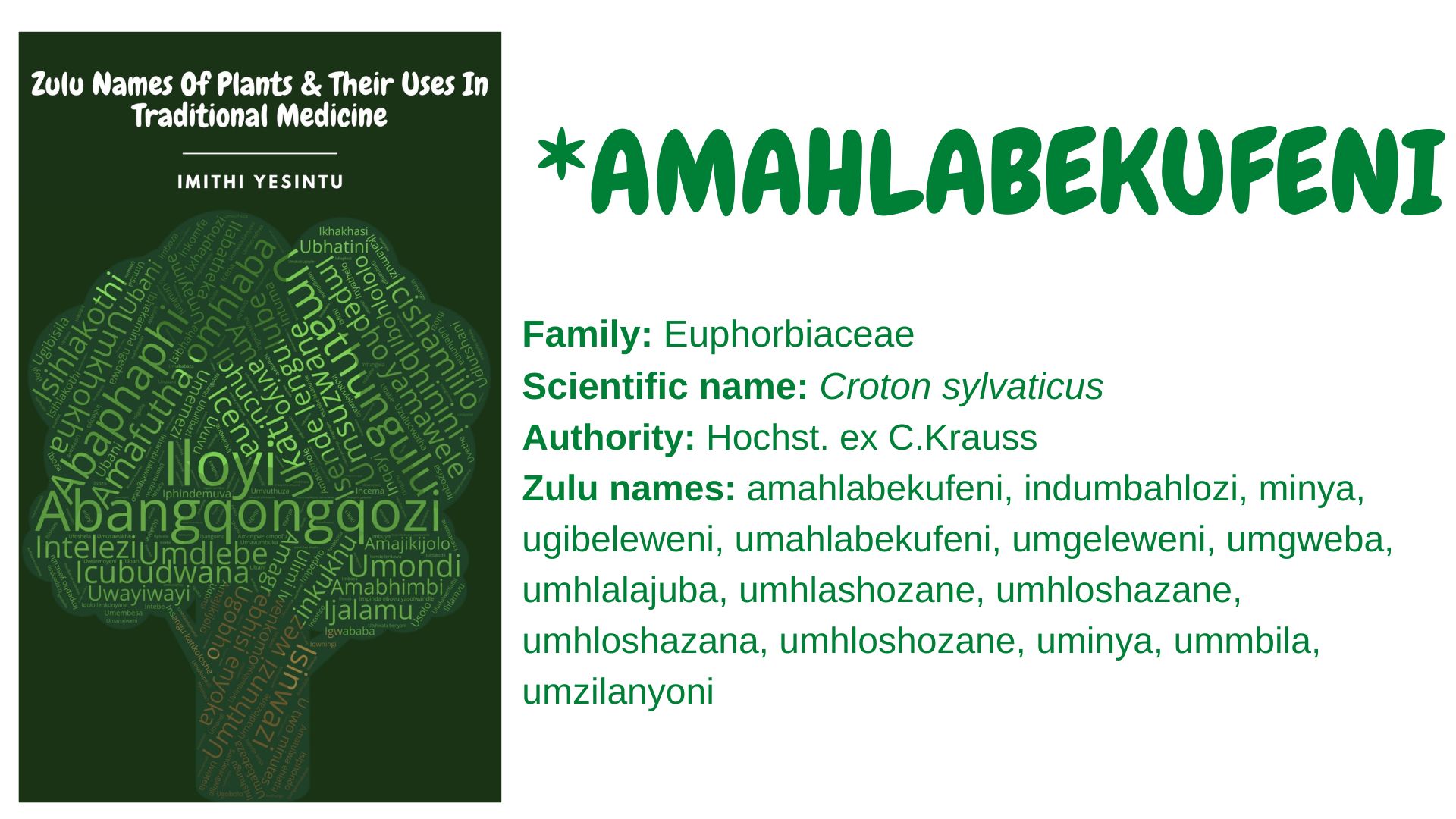Family: Euphorbiaceae
Scientific name: Croton sylvaticus
Authority: Hochst. ex C.Krauss
Synonym: Oxydectes sylvatica (Hochst.) Kuntze
Zulu names: amahlabekufeni, indumbahlozi, minya, ugibeleweni, umahlabekufeni, umgeleweni, umgweba, umhlalajuba, umhlashozane, umhloshazane, umhloshazana, umhloshozane, uminya, umbila, umzilanyoni
Other names: forest croton, fever tree, forest fever berry (English) boskoorsbessie, koorsboom (Afrikaans)
Plant description: C. sylvaticus is a medium-sized to large tree that grows in the bushveld and mixed forest habitats. It has large ovate leaves with a pointed tip, greenish-white flowers, and trilobed round capsule fruits that turn orange-to-red when ripe.
Uses:
- The bark is used as a substitute for Ocotea bullata.
- The bark is mixed with other plants and burned, the smoke is inhaled to treat insomnia.
- The bark is charred and ground to fine powder, then applied to treat bleeding gum.
- The bark is pounded and boiled, the liquid is administered as a drink to treat stomach and intestinal pains and constipation.
- The bark decoction is applied topically for wound healing and to treat skin irritation.
- The bark is ground to powder and administered as snuff to treat headaches.
- The powdered bark is licked to treat body pains.
- The bark is used to make an infusion that is taken to treat chest pains, fever, and tuberculosis.
- The bark is mixed with other herbs to make a tonic to treat listlessness.
- The leaves are used to make poultice that is applied topically to treat sores.
- The plant is used to make an infusion to treat inflammation.
- The wood is used for construction (poles and posts) and as fuelwood (firewood and charcoal).
Safety precaution:
Using traditional medicine responsibly can enhance your overall health and well-being. Misuse and abuse can lead to complications. You can inquire about the correct use of traditional medicine from a knowledgeable herbalist and practitioner. You can also visit imithiyesintu.co.za or email: info@imithiyesintu.co.za to learn more about traditional medicine
References and further reading:
- Boon, R. 2010. Pooley’s trees of eastern South Africa, Flora and Fauna Publications Trust.
- Hutchings, A., Scott, A.H., Lewis, G. and Cunningham, A., 1996. Zulu medicinal plants. Natal University Press, Pietermaritzburg.
- Maroyi, A., 2017. Traditional usage, phytochemistry and pharmacology of Croton sylvaticus Hochst. Ex C.Krauss. Asian Pacific Journal of Tropical Medicine 10, pp. 423-429.
- Mathe, T., 2021. A phylogeny-based comparative study of the phytochemical and pharmacological characteristics of Croton species occurring in KwaZulu-Natal (Doctoral dissertation).
- Mhlongo, L.S. and Van Wyk, B.E., 2019. Zulu medicinal ethnobotany: New records from the Amandawe area of KwaZulu-Natal, South Africa. South African Journal of Botany, 122, pp.266-290.
- Ndawonde, B.G., 2006. Medicinal Plant Sales: A case study in northern Zululand (Doctoral dissertation).
- Khumalo, G.P., 2018. An inventory of the most popular medicinal barks sold on Johannesburg muthi markets and the antimicrobial activity of selected extracts and isolated chemical compounds. University of Johannesburg (South Africa).[zulu names & uses]
- Komoreng, L., Thekisoe, O., Lehasa, S., Tiwani, T., Mzizi, N., Mokoena, N., Khambule, N., Ndebele, S. and Mdletshe, N., 2017. An ethnobotanical survey of traditional medicinal plants used against lymphatic filariasis in South Africa. South African Journal of Botany, 111, pp.12-16.
You Can Order Your Copy Of The Book By Emailing: info@imithiyesintu.co.za
Feel Free To Add Other Uses Of This Plant In The Comment Section Below:

